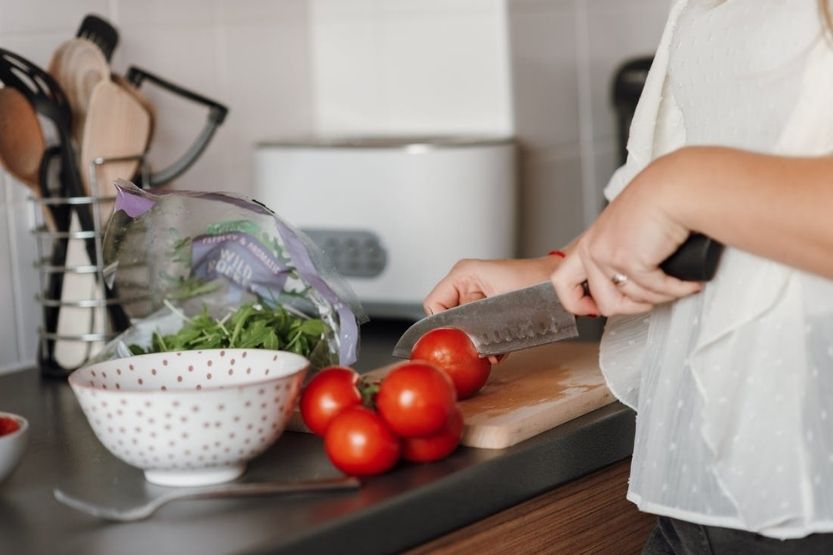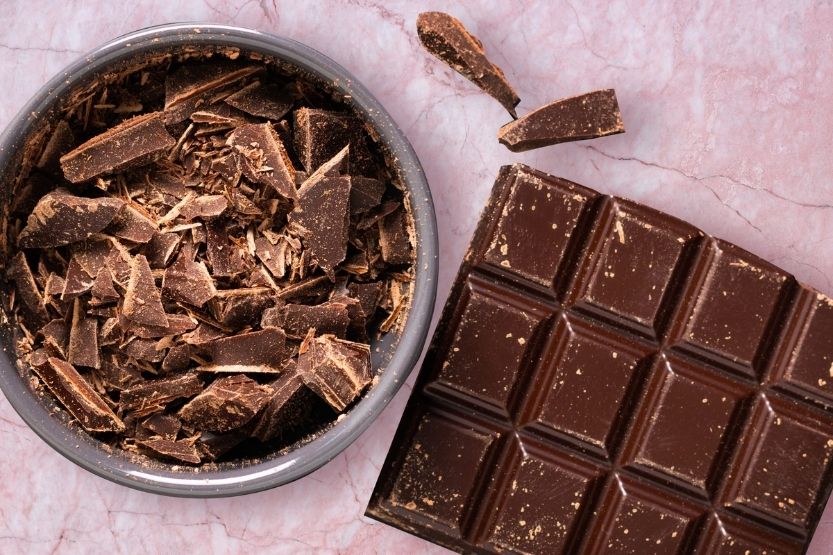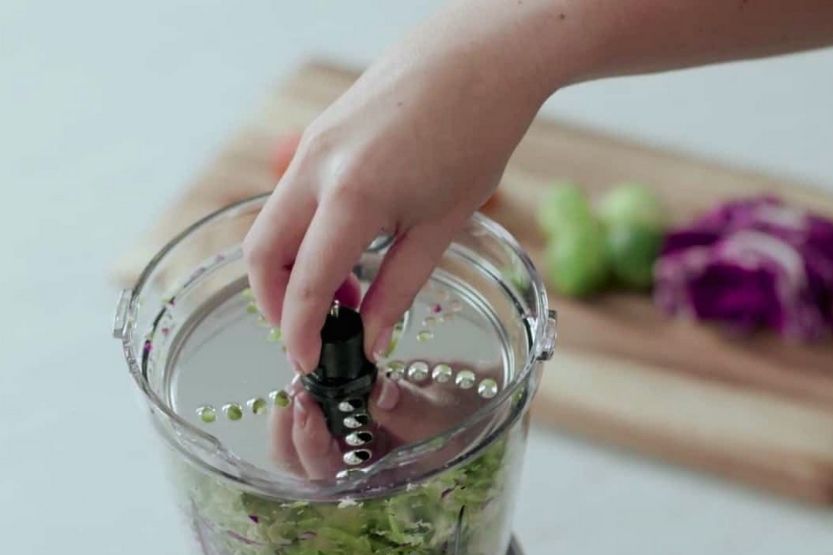If you are a complete newbie in the kitchen, you probably do not know what does coarsely chopped mean? And yes, it is different from other chopping techniques.
The basic definition of coarsely chopped is to cut whatever it is into roughly half-an-inch pieces. You don’t need to be exact. You can eyeball the sizes of the pieces. The purpose of coarsely chopping ingredients is so that they all cook at the same time.
Read on to learn more about what coarsely chopped means and how you can do it in your kitchen.
What Does Coarsely Chopped Mean?

Coarse chopping or roughly chopping ingredients means that you make sure they are approximately the same size. The ingredients should also be small enough to cook in a short time.
Most of the time, coarsely chopped ingredients are for home cooking. This means you are not worried too much about the presentation. It does not matter if the ingredients in your dish are perfectly sliced.
However, that does not mean you can just cut the ingredients willy-nilly and throw them into the pot. Ensure that the ingredients are also small enough that they would cook quickly.
The following are simplified instructions on coarsely chopping some of the most common kitchen ingredients.
Coarsely Chopped Onion
1. Peel and Halve the Onion
It is easier to peel an onion by cutting it in half first. After that, slice off the upper part of the onion. Peel off the outer skin. Sometimes, you also need to peel away the first layer. Leave the end with the roots alone for now.
2. Make Two to Three Horizontal Slits
Lay the onion halve with the cut side down on the chopping board. Hold the top of the onion down. Make two to three horizontal, parallel slices into the onion from the top to the base of the vegetable.
You can make more slits if you’re preparing a large onion and fewer if you chop a smaller one.
3. Slice the Top
Move your knife to the top of the onion. Now make 3 to 4 cuts along the length of the onion. Make sure that the cuts are at least half-an-inch thick.
4. Chop Across
Angle your knife perpendicular to the previous cuts, and then chop the onion into half-inch or so squares. Continue shopping until you are left with nothing else but the base of the onion.
Repeat with the other half. You can skip the second step for small onions and go straight to step 3.
Coarsely Chopped Carrots
Coarsely-chopped carrots are essentially the same as medium-diced. However, you don’t need to make each piece a perfect cube. You have to make them roughly the same size:
1. Peel the Carrot
Clean the carrot thoroughly by scrubbing it under the faucet. Cut off the top of the carrot and peel the outermost layer. However, just like potatoes, you can leave the skin on. Ensure that you completely clean it.
2. Cut the Carrot into Halves
Depending on the size of the carrot, you can cut the vegetable into two or three large pieces. This is only to make them easier to slice.
3. Slice Each Chunk into 1/2-inch Strips
Stand a chunk of the carrot on its end. Cut the carrot lengthwise, creating half-inch slices. Do this with all the cut carrot pieces.
4. Cut the Slices into Half-inch Strips
Lay the carrot slices flat on the cutting board and cut them into half-inch strips. To make the process faster, stack around 4 to 5 slices on top of each other. After that, you can cut them into strips.
5. Cut the Strips into Rough Cubes
Grab a small bundle of carrot sticks and firmly hold them together with your fingertips. To keep you from slicing your fingers open, curl your fingers a bit when holding the carrot sticks.
You have to tuck your fingertips under your knuckles. Because your fingertips are away from the knife’s blade, cutting yourself will be more unlikely.
Rest the flat of your knife against the knuckles of your fingers, and then start chopping. Move your fingers to approximately the same size you want each piece to be. Repeat until you have chopped all the carrot sticks.
How Do You Soften Baby Carrots Quickly?
Coarsely Chopped Tomatoes
The key to perfectly chopping tomatoes is to use a sharp knife. If your knife is dull, it won’t cut through the tomato. It will just crush it instead:
1. Rinse the Tomatoes
Grab a tomato and lightly rinse and scrub it until it’s clean. Do not be too rough as you might bruise it. Place the tomatoes in a colander and let them drain a little. While rinsing the tomatoes, pull out the stems.
2. Cut Each Tomato into Quarters
Slice each tomato into halves lengthwise, and then cut each half lengthwise. If you are dealing with a large tomato, you can slice each segment into two pieces.
3. Slice Across Each Segment
Line a couple of segments alongside each other. Place the point of your knife at the upper side of the segments, and then pull the knife downward. If your knife is sharp, it would just glide through each piece. Slice each tomato segment into half-inch pieces.
Coarsely Chopped Chocolate

Because chocolate is harder than vegetables, coarsely chopping will require more force. Also, the knife should have a curved bladed edge. You can use a chef’s knife, or if you have one, a two-handled rocker knife, also called a mezzaluna.
1. Break the Chocolate Bar into Smaller Pieces
Lay the chocolate on the cutting board and roughly chop the bar into several pieces. The pieces need not be the exact sizes or shapes.
2. Proceed to Chop Using a Rocking Motion
Place the point of the knife on the chopping board. Hold it in place using your other hand, and then chop the chocolate pieces. Chop the chocolate into the ideal chunk size using a rocking and pivoting motion.
The coarsely chopped chocolate pieces have random shapes and sizes. However, it should be fine if the biggest chunks are no bigger than ¾ of an inch.
Coarsely Chopped Garlic
1. Separate the Garlic Cloves
Grab a head of garlic, and then press your thumb into the top part. This will cause each garlic clove to loosen its hold on the vegetable base.
2. Peel the Garlic Cloves
Cut off the garlic cloves’ roots first. Then lay the garlic clove on the cutting board. Lay the flat side of your knife on the garlic clove. Press on it using the palm of your hand and a bit of your body weight to it. The skin should split apart, and you can easily pick it off the actual garlic clove.
3. Chopping the Garlic
Hold the garlic clove with your fingertips, and then chop the garlic using a slow rocking motion. You can use a short chopping motion if you have a sharp knife.
Again, what is the definition of coarsely chopped? When the recipe calls for a coarsely chopped ingredient, it means you have to cut it into around 1/2 inch. You don’t have to be exact as long as the ingredients are roughly the same size. This way, they have the same cooking time.
Coarsely Chopped Zucchini
1. Wash the Zucchini
Gently rinse the zucchini under running water. Ensure to get as much of the dirt off the surface as possible. The reason is that you will not be peeling this vegetable.
2. Slice the Zucchini in Half
Place the zucchini on a cutting board and cut a bit off both ends. Slice the zucchini straight down the middle. Don’t worry about being too precise. This will be a coarse chop, after all.
3. Slice the Halves into Strips
Place each half of the zucchini cut side down on the cutting board. Slice each half lengthwise, making 3 to 4 slices; again, no need to be precise.
4. Chop the Zucchini Strips
Hold the zucchini strips with your fingertips curled underneath the knuckles to prevent accidents. Proceed to chop across the zucchini strips, making each piece around half an inch thick. Use a rocking motion with your knife. Keep the tip of the blade on the chopping board as much as possible.
Why Do You Need to Coarsely Chop Ingredients?
When a recipe calls for an ingredient to be coarsely chopped, it should be in small pieces. However, it does not necessarily mean it should be minced. After chopping the ingredient, each piece should be at least half an inch long.
The reason for coarse chopping is to give the ingredients a somewhat uniform look and size. You can often use this when you need to sauté the ingredients. Coarsely chopping the ingredients will help them cook faster and more evenly.
Another reason coarse chopping is needed is that some ingredients lose their “bite” when chopped too finely. For instance, the ingredients should still be distinct in a vegetable stir fry. It should not look like a homogenous paste.
Can You Use a Food Processor to Coarsely Chop Ingredients?

It is an excellent idea to use a food processor if you prepare many ingredients. This is also recommended if you need to chop small and hard ingredients, like nuts:
Cut the Ingredients Into Manageable Pieces
Slice the ingredient into chunks to coarsely chop using a food processor. That way, they can easily fit inside the appliance. For instance, if you chop celery, cut the stalks into three to four pieces each. You can then throw them into the food processor.
Pulse the Ingredients Until Chopped
You can then give the food processor a couple of quick pulses. Check if the size of the pieces is acceptable. If not, stir the contents using a spoon and give it a couple more pulses.
Often, you can use a food processor to chop nuts. The reason is that they are quite small and hard to hold still on a chopping board. You can do that with these steps:
Place A Handful of Nuts in the Processor
It is better to chop a handful of nuts in the processor to prevent them from jamming. Filling the food processor with nuts will cause the bottom layers to get chopped up before the others on top.
This means the bottom layers of nuts will turn into nut butter, but the ones on top will remain whole.
Pulse the Food Processor
Pulse the food processor for a couple of seconds. Check if the nuts are not quite the consistency you want. If the chunks are still too big, give the food processor container a good tap on the counter. After that, pulse it again.
What Type of Knife Is Best for Chopping?
What kind of knife is best for chopping ingredients? Different knives serve different purposes. You can technically use any knife for chopping ingredients. However, it will not be as efficient or easy to use. For instance, you can use a paring knife to chop garlic roughly, but it will require more effort.
To give you an idea of what kind of knife you can use, here are some suggestions:
1. Chef’s Knife
If you can choose the one knife you can keep forever, it should be the chef’s knife. This type of knife is a sort of Jack-of-all-trades. It has a pointed tip for precise cutting and a curved edge that makes it great for chopping ingredients. It also has enough heft for cleaving through the meat.
2. Cleaver
A cleaver, also called a butcher’s knife, might seem too large and bulky for chopping. Despite that, it is the one knife that most Chinese chefs use.
The width of the cleaver makes it safer since you can guide the blade easier. Also, the handle is set high above the cutting edge. This makes this knife ideal for chopping coarsely and finely.
3. Santoku
The term “Santoku” is Japanese for “three uses.” For this knife, the three uses are chopping, dicing, and mincing. Just like a chef’s knife, the santoku can make chopping vegetables easily.
Also, because the knives have unique dimpling stamped on their sides, they prevent ingredients from sticking to them. This is great for when you are preparing large vegetables.
4. Nakiri
This knife is especially ideal for chopping vegetables. It has a square shape and a mostly straight cutting edge. The unique shape means the entire length of the blade can chop through the cutting board.
This means you do not need to rock the blade to chop ingredients. Aside from chopping, the nakiri is also great for julienning and cutting thin and even slices.
5. Tomato Knife
The name of the tomato knife may suggest that it is only for use on tomatoes. Note that you can also use it to cut other kinds of vegetables.
These knives usually have sharp serrated edges. These edges promote ease in cutting through fleshy vegetables and fruits, like tomatoes, eggplants, etc.
Safety Tips When Chopping Vegetables
The following safety tips can also guide you in chopping vegetables with ease:
1. Ensure That Your Chopping Board Does Not Slip
When you are handling a sharp knife to chop small objects, the base should be as solid as possible. To prevent the board from slipping and sliding around, place a thin kitchen towel underneath.
2. Hold The Knife Properly
Most people think they should only grasp the knife’s handle when chopping, but that’s not the case. When you are holding a kitchen knife, your thumb and forefinger should be “pinching” the top of the blade. The other fingers also have to be curled around the handle.
This prevents the knife from twisting around in your hand. The twisting sometimes happens when the knife and your hands get wet during ingredient preparation. With the help of this grip, you can also obtain better control over the knife.
3. Use The Claw Grip
The claw grip is when you hold the ingredient you are chopping with fingers curled underneath your knuckles. This keeps your fingertips away from the cutting edge while still controlling where the blade goes.
This keeps your hand safe. Your knuckles serve as a bumper that keeps the knife’s sharp edge from reaching your fingertips.
4. Stabilize The Ingredients You’re Chopping
Ensure that the ingredients you will be chopping are not rolling around on the cutting board. Aside from making it difficult to do a uniform cut, it also makes your knife slip and accidentally cut you.
To make sure that your ingredients are stable, cut them into manageable pieces. Lay the vegetables cut side down on the board.
Conclusion – What Does Coarsely Chopped Mean?
To coarsely chopped means you have to cut the ingredients into roughly 1/2” pieces. You don’t need to cut each piece precisely. You can eyeball the rough size. The reason why cooks rough chop ingredients is so they would cook quickly and simultaneously.
Coarse chopping is one of the basic skills you will need in the kitchen. Hopefully, you learned the basics of this cooking skill and got as much practice. That way, you can do it faster and more efficiently.
Read next:



![Read more about the article How to Thicken Teriyaki Sauce? [Plus Easy Recipe]](https://howchimp.com/wp-content/uploads/2020/08/how-to-thicken-teriyaki-sauce-300x200.jpg)